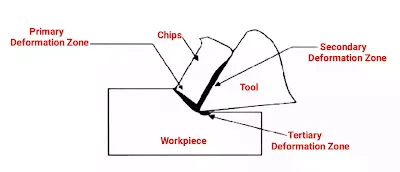Hello, friends today we are going to explain heat generation in metal cutting as well as also know what its effects are and how to control heat generation in metal cutting.
Heat is generated during machining operation through lathe machine, planer machine, slotter machine, milling machine, etc.
Nowadays, all these machines are fully automated which work on cnc machining.
In a machining operation, energy supplied is converted into heat energy in the heat zone.
According to the first law of thermodynamics,
The heat generated = Work done
= f×v (N-m/min)
Where,
f is cutting force in N
v is cutting speed in m/min
So without wasting time let's get started
Heat Generation in Metal Cutting
While machining operation is performed, a large amount of heat is generated from the cutting point at three different points which are:
- Heat generation at the shear plane
- Heat generation at tool chip interface
- Heat generation at tool work interface
Heat Generation at Shear Plane
The mechanism of shearing of metal is the reason to generate the heat around the shear plane.
In this region during the metal cutting operation, plastic deformation of metal takes place on the shear plane due to shearing action in metal heat is generated.
A very minor portion of heat is retained by the workpiece.
In this region, 70% heat is generated by chip 20% by the workpiece, and 10% by the tool.
The shear plane is also known as the primary deformation zone where the major part of the energy is converted into heat.
Heat Generation at Tool Chip Interface
This is the region that occurred at the chip tool interface where further heat is generated due to rubbing or shear.
At the tool chip interface energy supplied is converted into heat energy due to friction at tool-chip contact.
Out of this maximum amount of heat is carried by chip and a small amount to the tool.
That means 80% heat is generated by the chip and 20% amount of heat is generated by a tool.
It is also known as the secondary deformation zone.
Heat Generation at Tool Work Interface
At the tool work interface energy supplied is converted into heat energy due to friction between tool and workpiece.
As the cutting tool is not perfectly sharp, there exists friction between the tool and the newly machined surface.
Some portion of the flank surface will be in contact with the workpiece which rubs against each other, which is another source of heat generation.
From here maximum heat is transferred to the workpiece and a small amount to the tool.
Therefore total heat generated during metal cutting is carried away by chip, tool, and workpiece.
It is also known as the tertiary deformation zone.
So in this region, 70% heat is generated by chip 20% by tool, and 10% by the workpiece.
Effects of Heat Generation in Metal Cutting
There are the following effects that occurred during heat generation in metal cutting.
- Rapid tool wear and decreases tool life.
- Cutting edge plastically deforms and Loss of hot hardness.
- Thermal flaking and fracturing of cutting edge.
- Built-up edge formation.
- Dimensional inaccuracy due to thermal expansion of workpiece.
- The surface of work may damage due to oxidation and burning.
- Microcracks at the work surface so the physical properties of a workpiece may change.
- Residual stress can be developed.
- Operator hazards.
Control of Heat Generation in Metal Cutting
Most heat generation in metal cutting occurred when continuous chips are formed to avoid this chip breakers are used.
Apart from this, heat generation can be controlled by adopting the following methods.
- Proper selection of tool material.
- Proper selection of tool geometry.
- Optimum cutting speed.
- Selection of cutting fluid.
- Application of special technique.
So friends here you have to know the heat generation in metal cutting as well as their effects and how to control it.
I hope you all enjoy this topic and clearly understand still if you have any doubts or questions then you can ask me through a comment or direct mail to me I will definitely reply to you.
FAQ for Heat Generation in Metal Cutting
What are the three main regions of heat generation in metal cutting?
The three main regions of heat generation in metal cutting are the Shear plane, tool chip interface, tool work interface.
What are the heat resources in metal cutting?
In metal cutting, heat is generated in three zone, first is the primary heat zone where heat is generated due to shearing action, second is the secondary heat zone where heat is generated between the cutting tool and the chip and third is the tertiary heat zone where the heat is generated between the tool and the workpiece.




0 Comments